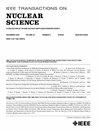Multiple-Cell Upset Analysis on 16/12-nm Bulk FinFET SRAM Caused by Proton Irradiation
IF 1.9
3区 工程技术
Q3 ENGINEERING, ELECTRICAL & ELECTRONIC
引用次数: 0
Abstract
The effects of proton-induced multiple-cell upsets (MCUs) on 16 and 12-nm fin field effect transistor (FinFET) static random access memories (SRAMs) were studied. Their dependence on the incident angle and supply voltage is discussed in terms of the MCU size and the fail-bit map (FBM). For perpendicular proton irradiation, we compared the MCU characteristics of FinFET SRAMs with 20-nm bulk planar SRAMs. In the proton energy dependence of single event upset (SEU) cross section, peak structures caused by proton direct ionization (PDI) were observed. At the nominal voltage condition, the peak was observed in the 20-nm bulk planar SRAM, but not in the 16 and 12-nm FinFET SRAMs. At the low voltage condition, however, the peak was observed even in the FinFET SRAMs. For the 16 and 12-nm FinFET SRAMs, the maximum size of MCUs was 3-bits, whereas that was 7-bits for 20-nm bulk planar SRAMs. Furthermore, the differences in the physical pattern of MCUs are observed between 16-nm FinFET and 20-nm SRAMs in perpendicular proton irradiation, where the 16-nm FinFET SRAM tends to have a rectangular shape with a longer side in the bitline (BL) direction. This clearly suggests that multiple-bit upsets (MBUs), which are known as uncorrectable MCUs, hardly occur in 16 and 12-nm FinFET SRAMs. For the angular irradiation, MBU probability in all MCU events reached 73% when tilting the SRAM at 75° across the fin body direction. However, the observed MBU size was up to 2-bits, indicating that bit-interleaves with more than 2-bits can be effective for mitigating MBUs in 16 and 12-nm FinFET SRAMs.质子辐照对16/ 12nm块体FinFET SRAM的多电池破坏分析
研究了质子诱导多细胞扰动(MCUs)对16和12 nm翅片场效应晶体管(FinFET)静态随机存取存储器(sram)的影响。从MCU尺寸和故障位图(FBM)的角度讨论了它们对入射角和电源电压的依赖关系。在垂直质子辐照下,我们比较了FinFET sram与20 nm本体平面sram的MCU特性。在单事件扰动(SEU)截面的质子能量依赖中,观察到质子直接电离(PDI)引起的峰结构。在标称电压条件下,在20纳米块体平面SRAM中观察到峰值,而在16和12纳米FinFET SRAM中没有观察到峰值。然而,在低电压条件下,即使在FinFET sram中也观察到峰值。对于16和12纳米FinFET sram, mcu的最大尺寸为3位,而对于20纳米大块平面sram, mcu的最大尺寸为7位。此外,在垂直质子辐照下,16纳米FinFET SRAM和20纳米SRAM在mcu的物理模式上存在差异,其中16纳米FinFET SRAM在位线(BL)方向上趋向于具有较长的矩形形状。这清楚地表明,被称为不可校正mcu的多位扰流(MBUs)几乎不会发生在16和12纳米FinFET sram中。对于角度辐照,当SRAM沿鳍体方向倾斜75°时,所有MCU事件的MBU概率达到73%。然而,观察到的MBU尺寸高达2位,这表明超过2位的位交织可以有效地缓解16和12纳米FinFET sram中的MBU。
本文章由计算机程序翻译,如有差异,请以英文原文为准。
求助全文
约1分钟内获得全文
求助全文
来源期刊

IEEE Transactions on Nuclear Science
工程技术-工程:电子与电气
CiteScore
3.70
自引率
27.80%
发文量
314
审稿时长
6.2 months
期刊介绍:
The IEEE Transactions on Nuclear Science is a publication of the IEEE Nuclear and Plasma Sciences Society. It is viewed as the primary source of technical information in many of the areas it covers. As judged by JCR impact factor, TNS consistently ranks in the top five journals in the category of Nuclear Science & Technology. It has one of the higher immediacy indices, indicating that the information it publishes is viewed as timely, and has a relatively long citation half-life, indicating that the published information also is viewed as valuable for a number of years.
The IEEE Transactions on Nuclear Science is published bimonthly. Its scope includes all aspects of the theory and application of nuclear science and engineering. It focuses on instrumentation for the detection and measurement of ionizing radiation; particle accelerators and their controls; nuclear medicine and its application; effects of radiation on materials, components, and systems; reactor instrumentation and controls; and measurement of radiation in space.
 求助内容:
求助内容: 应助结果提醒方式:
应助结果提醒方式:


